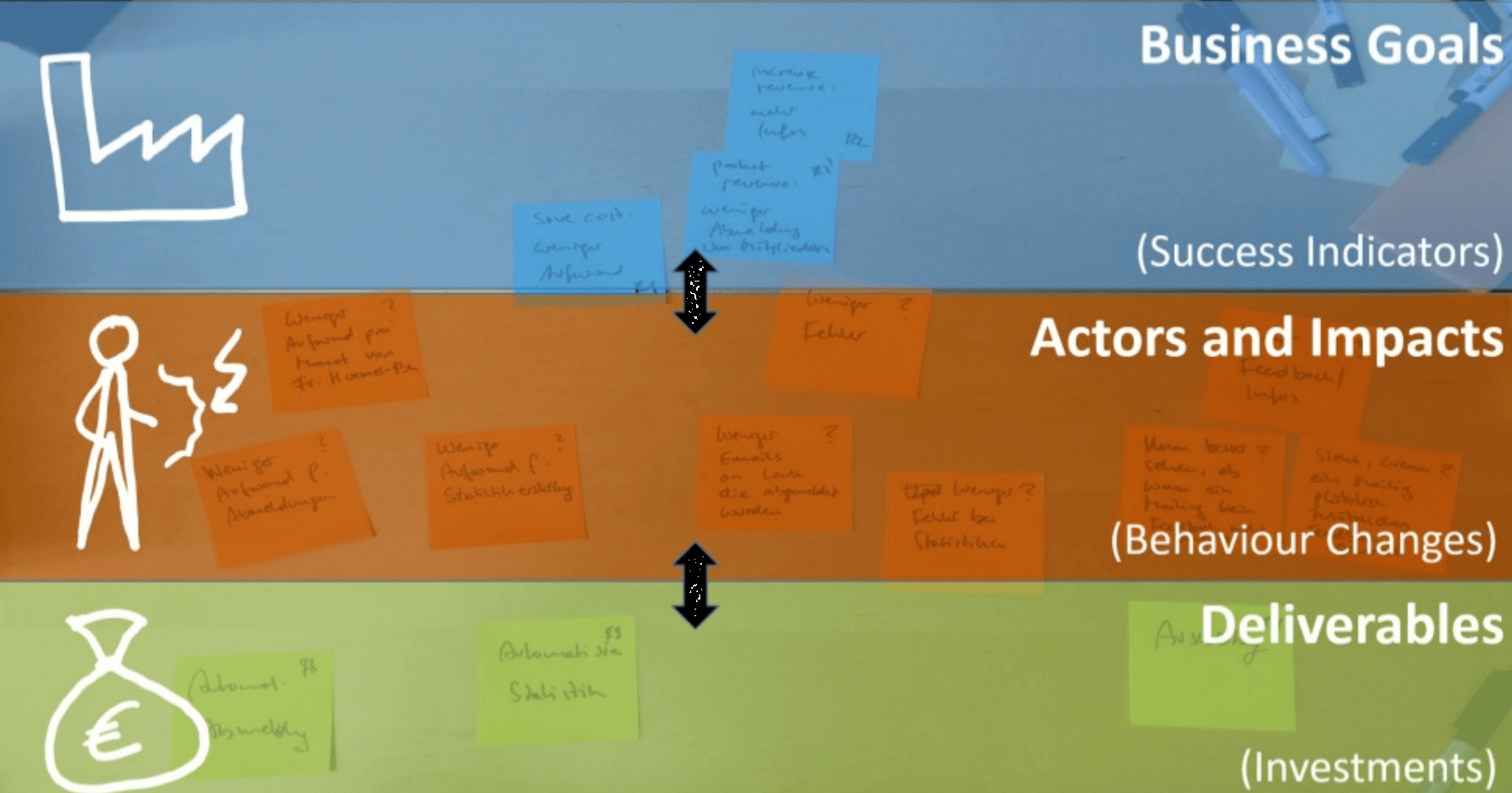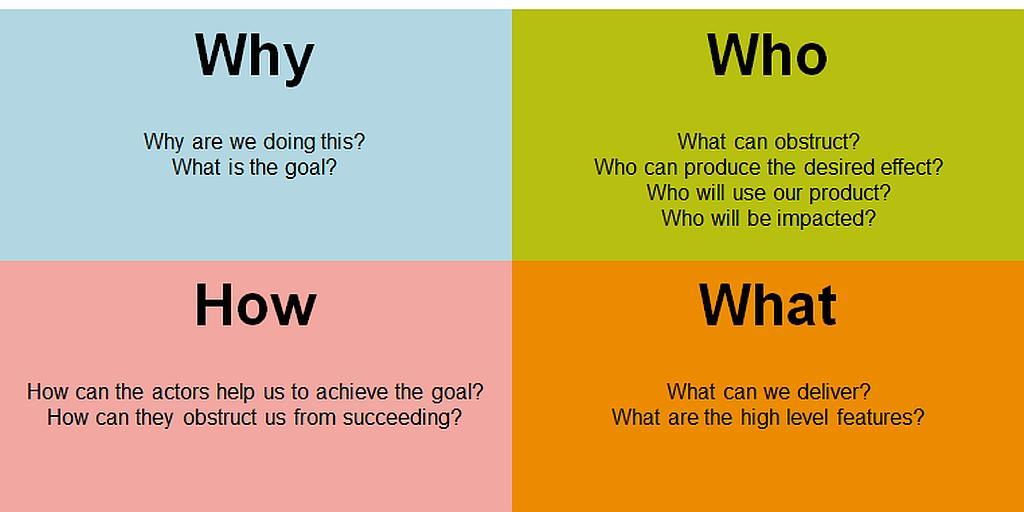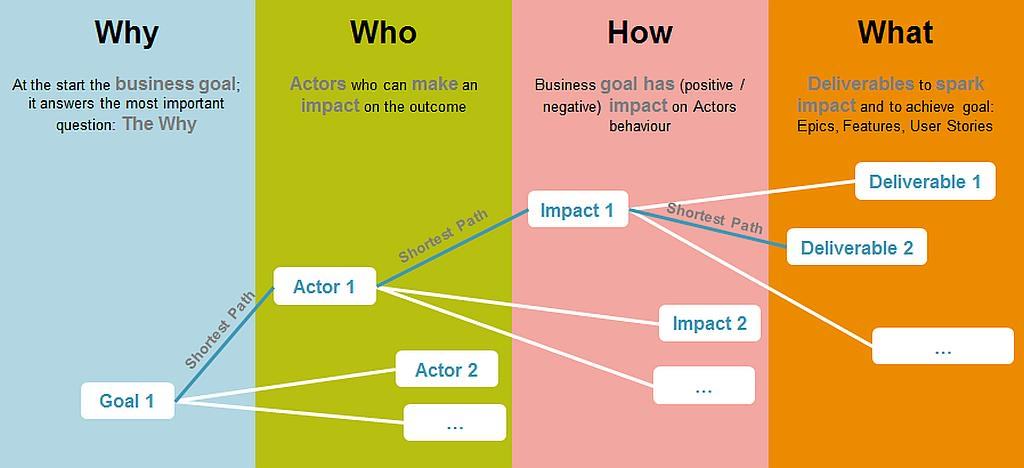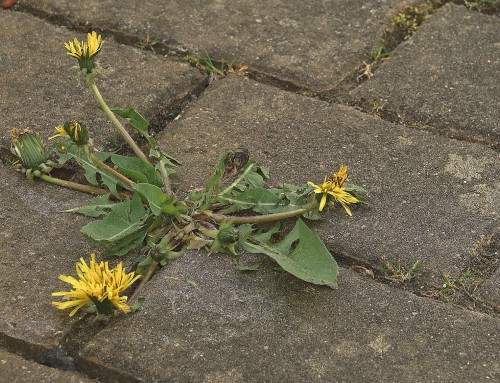Impact Mapping — How To Use It
Background and Evolution of Impact Mapping
 Impact mapping is a visual mapping technique for product development. Gojko Adzic, a Serbian software consultant — who moved to the UK — invented this method to align development teams to business objectives, to test mutual understanding of goals and expected outcomes with stakeholders, to focus teams toward the highest value features to deliver, and to enable collaborative decision-making.
Impact mapping is a visual mapping technique for product development. Gojko Adzic, a Serbian software consultant — who moved to the UK — invented this method to align development teams to business objectives, to test mutual understanding of goals and expected outcomes with stakeholders, to focus teams toward the highest value features to deliver, and to enable collaborative decision-making.
At its origin, it was considered as a user experience strategy and design technique for agile teams to gather requirements, create user stories, and develop fast UX mockups.
Nowadays, impact mapping has taken off from its roots and is adopted by small startups and as well by big enterprise software companies. Impact mapping is an established, general tool for strategic business planning:
- It helps the team to focus on delivery by setting deliverables in the context of the impacts they are supposed to achieve.
- It restricts an initiative to the least essentials by prioritizing impacts and deliverables.
- It enhances collaboration by creating a shared big picture and understanding between technical and business people.
Purpose of Impact Mapping
- Strategic Planning – Strategic goals for new products (deliverables);
New products (deliverables) for new strategic goals - Define Quality – Agreements on purpose of deliverables
Agreements on metrics of change - Roadmap Management – Agreements to achieve Business goals
Frequent iterative releases to measure progress
Agreements on metrics for central business goals
The “Why”, The “Who”, The “How”, and The “What”
By impact mapping, all parties involved are enabled to answer the ultimate question: “Why am I doing this?”, in a sense, “How the feature I am implementing now, gets the product closer to the business goal?”
The method is very easy to learn — most participants grasp the idea in at least 5 minutes. And it is very efficient — you get stupendous results within 1-2 day workshops.
In an impact mapping workshop teams construct a roadmap that helps them quickly learn whether a particular approach will produce the desired results and adapt to inevitable changes by answering the following questions: why, who, how, and what?
Since the participants of these workshops are interdisciplinary — product or process designers, business people, customers and clients, and other stakeholders — impact mapping is a highly collaborative discussion event to share mutual objectives, requirements, goals, and targets.
Impact mapping is a kind of collaborative journey from intended goals to deliverables needed to achieve these objectives. The paths are assumptions underlying and strengthening the objectives/goals. By mapping our assumptions we find the work/activities that can validate them.
An impact map is a visual mind map, grown collaboratively during a discussion facilitated by answering the fundamental four questions: "Why (Goals)?", "Who (Actors)?", "How (Impacts)?", "What (Deliverables)?"
Think of an Impact Map as a structured mind map, with the following levels being used to articulate the various aspects of an initiative:
- Why – The central node describes the goal of the initiative in a quantitative manner such that it can be measured.
- Who – These are the people who can either be a help or a hindrance in achieving the goal.
- How – These are impacts that need to be had on the actors for them to either help achieve the goal or minimise/avoid them being a hindrance.
- What – These are the deliverables which are hoped will create an impact on the actors to achieve the goal.
As a consultant or as an Agile coach, I'm often faced with clients phrasing their requirements and objectives as highly detailed solutions. Very often, the clients separate these objectives from the issues they come from — sometimes the issues were even forgotten ;-).
By standing as a group in front of a whiteboard, questioning the Whys, the Whos, the Hows, and the Whats, impact mapping is a simple and effective method, to get the focus back to the underlying problems and to discuss whether the considered approaches, people, and deliverables, are really the best fitting ones.
Loosely related to this topic is the talk by Paul Watzlawick: When the solution is the problem. Watzlawick tells a few stories that illustrate how having a certain solution in mind or having a certain mental model can be restricting in finding the right solution. — Thanks to Peter Gfader for pointing me to this.
The Why
The "Why" of impact mapping is strongly related to Simon Sinek’s Golden Circle which he describes in his book "Start with a Why" or his TED talk.
According to Sinek consists the Golden Circle of three layers:
- Why - This is the core belief of the business. It's why the business exists.
- How - This is how the business fulfils that core belief.
- What - This is what the company does to fulfil that core belief.
Ingrid Domingues explains the similarities between image maps and Simon Sinek’s Golden Circle straight forward:
"the impact map describes the business and user values that a new product or service is expected to generate.
- why this solution is a good investment for the business
- how people are going to gain from it
- what the solution should encompass in order to promote user satisfaction and business prosperity."
Lisa Crispin writes about this
"our stakeholders come to us and say, “Give us a UI that does X, Y, and Z.” They often want to give us the implementation, despite the fact that they hired us because we’re the ones who know how to develop the software. When customers do this, it’s important to ask them the following questions: “Why do you want this feature? What business problem are you solving? What value will it add? How will we measure whether it was successful after we release it to production?” Once we understand the purpose, we can apply our own technical and domain knowledge as well as our creativity to come up with the simplest effective solution.
Thus, the "Why"-question leads us to the following two questions:
- Do you solve the right problem? and How do you know?
- How do you measure the success of your product/service?
To answer the "Why" question, Gojko suggests to use the acronym “SMART”: “Specific, Measurable, Action-oriented, Realistic, and Timely” — according to Wikipedia, there are multiple variants to interpret SMART. For multiple goals use the well-known MoSCoW prioritisation method: "Must have, Should have, Could have, Won't have". Through the exercise, recursively check the goal back to the basic premise. What we believe will help us accomplish our business needs (e.g. increased revenue, reduction in cost, etc.).
Through this exercise, recursively check the goal back to the basic premise. What we believe will help us accomplish our business needs (e.g. increased revenue, reduction in cost, etc.). This approach is similar to identifying goals and objectives for Key Performance Indicators and proper metrics.
This approach is similar to identifying goals and objectives top-down for Key Performance Indicators and proper metrics.
The Who
In the "Who" part of impact mapping, we investigate "Who can help us reach our goal?", "Whose behaviour do we want to impact?", "Who can produce the desired effect?", "Who can obstruct it?"
Think about people with whom you don’t normally collaborate. Be as specific as possible
“Music lovers who aren’t afraid of using the Internet to buy music” instead of “Everyone”.
Customer support and operations also have information that’s valuable to us. Sometimes people don’t know we even need help.
The How
The "How" part describes the impacts of our product or service: "How do we want to change the behaviour?", "How could our actors’ behaviour change to help us achieve our goal?", "Which behaviour is most likely to get us to our goal?".
Focus on what the actors most likely would do to support us to reach our goal, not everything they ‘can’ do. Consider behaviour that could potentially — or on purpose — hinder us as well.
Write each “who” on a sticky note, and group them to the goals.
The What
By answering the question "What can we do to support the behaviour change?" we find our “deliverables”. With this approach, we put the deliverables in the context of "Who it’s for?", and "Why it’s important".
If we design a technical product or service, these deliverables are the features and functionalities of the intended system themselves and related organisational activities.
If we use impact mapping instead as a general problem-solving tool to design business objectives or improvements, the “deliverables” are small experiments we will try to achieve the impact that will help us solve our problem.
In an HBR article, Deborah Mills-Scofield answered her own question "What’s the difference between outputs and outcomes?" as follows: outputs are extrinsic and outcomes are intrinsic. Usually, outputs are artefacts like documents, software programs, or other physical "shippable stuff ", like training, and workshops; outcomes are knowledge transferred and behaviours changed. Outcomes are the difference made by the outputs: better support service, a more convenient home banking experience. Outcomes are the benefit our customers receive from our output. Deborah makes this distinction exceedingly clear:
Outputs are important products, services, profits, and revenues: the What. Outcomes create meanings, relationships, and differences: the Why. Outputs, such as revenue and profit, enable us to fund outcomes; but without outcomes, there is no need for outputs.
Thus, when tracking the "What", we should focus on outputs and outcomes only, not on activities and effort to create them.
Divergent and Convergent Impact Maps
At the beginning of an impact mapping workshop, the participants identify more and more goals and relate actors, impacts, and deliverables to each. The impact map grows and gets divergent.
You should focus on “important” strategic goals. Prioritise related actors and impacts according to either (a) their potential to support the associated goal, or (b) your effort to “attract” them. The impact map shrinks and gets convergent.
Tips & Tricks For Impact Mapping
Additional useful tools for facilitating impact mapping workshops are:
- Lean Change Canvas to plan, track, and evaluate small experiments
- Innovation Games like Product Box, Buy me a Feature, Business Value Poker, Impact-Effort Matrix, or Prune the Product Tree to identify and prioritise goals and objectives, and Speed Boat to identify actors and behaviours.
See my related article to these.
Gojko gives in his book the following advice and tips:
Good goals tend to be SMART: Specific, Measurable, Action-oriented, Realistic and Timely. Goals should not be about building products or delivering project scope. They should explain why such a thing would be useful.
Expl.: "Starting to trade in Brazil by March next year", "Increasing user conversion by 20% in three months".
Important actors are those who can significantly influence the success of a project or product milestone, including end-users and internal or external decision-makers. Alistair Cockburn advises looking for three types of actors:
- Primary actors, whose goals are fulfilled, for example, players of a gaming system
- Secondary actors, who provide services, for example, the fraud prevention team
- Off-stage actors, who have an interest in the behaviours, but are not directly benefiting or providing a service, for example, regulators or senior decision-makers
Be specific. Avoid generic terms such as ‘users’.
Expl.: "Mike Smith from the marketing department", "Under-18 users with a mobile device at a concert", "Apple ITunes store approvers"
Identify the Impact right. — Don't list everything an actor might want to achieve. List only the impacts that really help move you in the right direction towards the central goal. Impacts are not product features. Avoid listing software ideas here, focus on business activities.
Ideally show a change in actor behaviour, not just the behaviour.
Expl.: "Inviting more friends", "Purchasing tickets without calling the call centre", "Selling tickets faster"
Identify the Deliverables right. — Don't try to make it complete from the start. Refine it iteratively as you deliver.
Treat deliverables as options, don't take it for granted that everything listed here will actually be delivered.
Expl.: "On-line ticket sales", "Mobile home page with purchase form", "Optimise call centre sales scripts", "Sign re-selling contracts"
Finally,
Never aim to implement the whole map. — Instead, find the shortest path through the map to the goal!
Further Readings
- Gojko Adzic: https://www.impactmapping.org
- Gojko Adzic: Open Impact Mapping Workshop
- Gojko Adzic (Book): Impact Mapping: Making a Big Impact with Software Products and Projects. 2012, Amazon
- Ingrid Domingues: The Evolution of Impact Mapping, 20 Feb. 2017
- Fabio Armani: Impact Mapping LEGO Game - Agile Business Day 2016, Slideshare.net, 19. Sep. 2016
- Chassa: Impact Mapping with Innovation Games, Slideshare.net, 19. Oct. 2016
- Alexander Byndyu: Impact mapping in practice, 27. Oct. 2015
- Lisa Crispin: Problem Solving with Impact Mapping, Agile Connection, July 9, 2013
- Gojko Adzic, Ingrid Domingues, Johan Berndtsson: Getting the most out of impact mapping, infoQ, Nov 08, 2014.
Other facilitation techniques I use
: Chassa, via SlideShare.net • uvd.co • varchannelmarketing.com via Pinterest.com, .












Leave A Comment